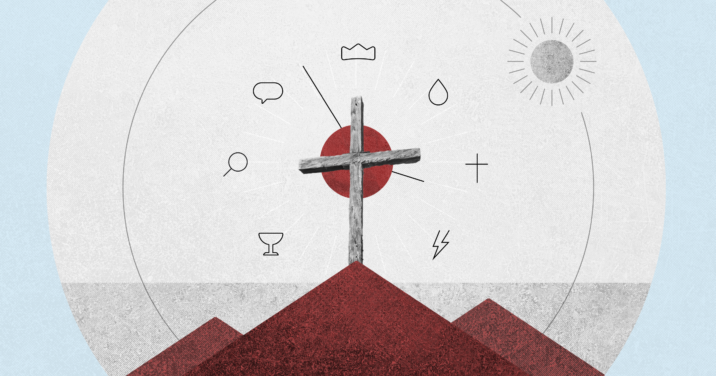Ever wondered, “When did Jesus die?” It’s a perfectly reasonable question as we near the celebration of Easter. The good news is there’s a fairly straightforward answer.
The Bible and historical records suggest Jesus died at three o’clock in the afternoon on Friday of Passover week AD 29.
If you think of the Passion narratives as a really old medical drama, you’ll see why specificity is difficult when discussing Jesus’s death.
In medical dramas, there’s a key moment when the medical examiner comes onto the scene and says, “Time of death is …” That’s when the story really gets started. That’s when we get to start figuring out who did it.
We never get that scene in the Gospels’ Passion narratives.
Don’t get me wrong. We know Jesus died. John describes a Roman soldier piercing Jesus’s side and blood and water gushing out (which was a sign that he was dead).
But there is no one on the scene to give the particulars of the death notice. The time of Jesus’s death wasn’t the utmost concern in the minds of the Gospel writers.
We don’t have enough clues from history and the biblical text to definitively say when Jesus died either. But we can come close.
In this article, I’ll share with you step-by-step how scholars have come to understand the dating of Jesus’s death—the year, the day, and the hour.
- Why the time of Jesus’s death matters
- What the Bible says
- What year did Jesus die?
- What day of the week did Jesus die?
- What time did Jesus die?
- Resources to help you dig deeper
- The Passion’s most important question
Why the time of Jesus’s death matters
Anytime you’re dealing with some of the minutia of biblical chronologies, it’s tempting to wonder whether any of it really matters. Can’t we just stick to the basics? We know Jesus died. We know God raised him from the dead. Who cares when he died?
The time of Jesus’s death isn’t the most important question in the Passion narratives. But it does matter.
For some (but not all) non-Christian religions, the events within their sacred texts aren’t thought of as historical. Their doctrinal commitments aren’t based upon specific events.
But Christianity rests within history. Our core message—the death, burial, and resurrection of Jesus—is shared through historical events. The historical nature of the gospel isn’t tangential. The historicity of the story is tied to the gospel itself.
So when we dive into the who, what, where, and when of the Passion narrative, we’re observing the gospel according to its historical character.
It matters when Jesus died because it helps us place the death of God’s Son in time. It helps us understand the people and the places involved in the story.
It also helps us apologetically to present the truth of the gospel story to others.

What the Bible says
First, it’s important to look at the chronology that Scripture lays out for the Passion narrative.
When you look at the crucifixion accounts in the Synoptic Gospels (Matthew, Mark, and Luke) and the Gospel of John, a basic outline emerges.
- After Pilate formally condemns Jesus to death, the Gospels tell us that Roman soldiers mock and beat him (Matt 27:27–30; Mark 15:16–19).
- The soldiers strip Jesus of the robe and put his own clothes back on. They find a man named Simon to carry the cross to Golgotha (the Place of the Skull, where he was crucified) for Jesus (Mark 27:31–34; 15:20–23; Luke 23:26–33; John 19:16–17).
- According to Mark, Jesus’s crucifixion begins at “the third hour,” or 9 a.m. (Mark 15:25). John says the soldiers begin to crucify Jesus at noon (John 19:14). Jesus is crucified between two criminals (Luke 23:33; Matt 27:39; Mark 15:27).
- Jesus prays for those crucifying him, asking for the Father to forgive them (Luke 23:34).
- The soldiers divide up Jesus’s clothing (Matt 27:35; Mark 15:24; Luke 23:34; John 19:23–25).
- Jesus asks John to look after Mary (John 19:26, 27).
- The soldiers, chief priests, and one of the criminals next to Jesus mock him (Matt 27:41–44; Mark 15:31–32; Luke 23:35, 39).
- One of the criminals asks Jesus to “remember me in paradise.” Jesus agrees to do so (Luke 20:40–43).
- Darkness falls on the crucifixion from noon until 3 p.m. (Matt 27:45; Mark 15:33; Luke 23:44).
- Jesus cries out to God (Mark 15:34; Matt 27:46).
- Jesus says he is thirsty and a spectator offers him a sponge soaked in wine (John 19:28–30).
- Jesus declares, “It is finished” and commends his spirit to the Father (Luke 23:46; Matt 27:50; Mark 15:37).
- Jesus dies (Matt 27:50; Mark 15:37; Luke 23:46; John 19:30).
- John tells us “since it was preparation day,” the Jews didn’t want the bodies to stay on the cross during the Sabbath (the next day), so soldiers broke the legs of the criminals so they would die quickly. That’s when they discovered he was already dead.
- A soldier then pierces Jesus’s side and blood and water come out of Jesus’s side, which is used as proof he was dead.
At that point, we move on to the burial.
A harmony of the Gospels is a great tool to build a timeline like what’s above. In many libraries and bookstores, you’ll find physical copies of Gospel harmonies. Each of these harmonies will answer the chronology and display the information a bit differently. They display the four Gospels, often story by story, side by side, letting you see how the Gospels handle different stories.
The Logos Bible app also has a digital tool, called the Parallel Gospel Reader, that shows you the four Gospels side by side in a digital format. You can pick and choose which translation and which Gospels you want to review in the tool. It also allows you to view these parallel Gospel accounts from the perspective of different New Testament scholars.
It’s important to remember that none of the Gospel writers was necessarily trying to give a play-by-play account of the last hours of Jesus’s life. All four of the writers, but particularly John, are using the narrative to explain the meaning of the crucifixion. We shouldn’t be surprised that they each tell a slightly different story. Still, these Gospel accounts largely present a unified timeline of events.
By the way, Eckhard J. Schnabel’s book, Jesus in Jerusalem: The Last Days, is an excellent source on the chronology of the biblical passion narratives. I used it to help me clarify my thoughts for the timeline above. It’s also very helpful as you look to get an understanding of all the cultural, religious, and chronological details of Jesus’s last week, particularly if you need to prepare a study for Easter week.
What year did Jesus die?
Since at least the time of Charlemagne in the ninth century, many Christians have assumed that the dates of Jesus’s life are settled fact. Because we used a dating system that counted the years since Jesus’s birth, then certainly he was born in AD 1 and died roughly thirty-three years later.
But most historians today believe the sixth-century monk Dionysius Exiguus, who first devised this dating system, probably did so using faulty calculations. So clarifying the year Jesus died isn’t as clear-cut as it might seem.
Most scholars put Jesus’s death somewhere between AD 28–33, with the AD 29 date being the most obvious year.
How do they get there? You can use one of two basic formulas for calculating the year of Jesus’s death. If you don’t do math (or it’s really early in the morning as you read this), you might skip to the next section.
First, you can use addition. Start with the commonly accepted date of Jesus’s birth. Usually, that’s between 4 and 6 BC, with 4 BC being the most likely. (There’s a lot of great reasonings for this, between the date for Herod the Great’s death, the dating of the census in Luke 2, and even the astronomical event that brought the magi to meet toddler Jesus, but that’s for another article.)
Most people believe that Jesus was thirty when John baptized him in the Jordan. Because John describes three Passovers during Jesus’s ministry (2:13, 6:4, 11:55), we usually say Jesus’s ministry was about three years long.
So if you add thirty-three years to 4 BC, you get AD 30. Remember, there was never a year zero. The medieval world didn’t have a concept for zero. In the BC/AD dating system, the world moved from 1 BC to AD 1. So 4 BC plus thirty-three years plus the year you lose between 1 BC to AD 1 equals AD 30.
But you can also get to a date around AD 30 (give or take a couple of years) by using a few clues from the text of the crucifixion. Cuthbert Hamilton Turner’s article on the Chronology of the New Testament in A Dictionary of the Bible: Dealing with Its Language, Literature, and Contents including its Biblical Theology uses two characters in the Passion narrative to narrow down the dates of the crucifixion.
First, there is Pilate. All the Gospels and the book of Acts tell us that Pilate was the governor at the time of Jesus’s death. Pilate couldn’t have been there any earlier than AD 27, according to Turner, and he probably wasn’t new on the job. That makes the earliest date for the crucifixion about AD 28.
Turner believes the high priest Caiaphas helps to set the late date for the crucifixion. He is believed to have been deposed as high priest at Passover in AD 34. That means the latest date of the crucifixion is AD 33.
A crucifixion under both Pilate and Caiaphas must fall somewhere between 28 and 33. The AD 30 date figured above fits nicely.

What day of the week did Jesus die?
Most people think they know the day of the week Jesus died because they celebrate the crucifixion on Good Friday. But a close look at the chronology of Holy Week will point to a problem.
Jesus predicted in Matthew 12:39–40 that he would be in the grave for three days and three nights. If Jesus died on Friday and then is put in the grave that night, that would mean he arose on Monday morning three days later.
But all four Gospels clearly put the resurrection on Sunday morning or the first day of the week (Matt 28:1; Luke 24:1; Mark 16:2; John 20:1).
For nearly two thousand years, the church has understood Jesus’s death to take place on a Friday and the resurrection on a Sunday.
The easiest explanation for this is that Jesus’s “three days and three nights” in the grave mentioned in Matthew 12:40 didn’t mean a seventy-two-hour period. Culturally, for Jews, it means part of one day, a full day, and part of the third day.
You see this with Esther. She told Mordecai that she was going to fast for “three days, night or day” before seeing the king (4:16). But in chapter 5, we’re told she visits the king on the third day.
Some Christians will use this apparent discrepancy to argue that Jesus died on Thursday. (At times, Wednesday is even suggested.) They note the Bible never specifically references Friday as the date of the crucifixion. They’ll add that Passover itself was considered a “Sabbath, or day of rest” so when Luke 23:52 notes “the Sabbath was about to begin” as they put Jesus in the tomb, it could also refer to Wednesday (the day before Passover).
But the vast majority of scholars subscribe to the view that Jesus died on Friday, the day before the Sabbath, and on the afternoon following the Passover meal. (Remember, days in Jewish culture go from sunset to sunset, so the Last Supper and the Crucifixion both fall on Nissan 15 from the perspective of those in Jerusalem at the time.)
What time did Jesus die?
Of all the chronological questions about the death of Jesus, this might be the simplest to answer, although we do have an apparent discrepancy within the Gospel narratives to clarify.
John and Mark describe the timing of the crucifixion somewhat differently. According to Mark 15:25, the crucifixion begins at the third hour of the workday (or nine in the morning). John, on the other hand, says it was “about” the sixth hour (or presumably noon) when Pilate asked, “Shall I crucify your king?”
A couple of things to keep in mind.
- The Gospel writers and their sources weren’t walking around with wristwatches. It’s likely they were making an estimation based upon the location of the sun in the sky.
- Plus, it’s possible that John is using the Roman calculation for when the day begins, where the count started at midnight.
In Jesus in Jerusalem: The Last Days, Schnabel suggests that the crucifixion began around eleven in the morning. That seems like a good approximation.
The synoptic Gospel writers say the darkness came between the sixth and ninth hours (noon to three in the afternoon). Jesus cries out at the end of that time. We know he is buried before sunset, so he likely died sometime between three to four in the afternoon.
Resources to help you dig deeper
People have been studying the chronology of the Passion narratives for close to two thousand years, yet there is still so much to learn. Whether you want to study when Jesus died or some other related topic, here are a few tools to help you dig deeper.
Logos Parallel Gospel Reader
With this tool, you can put the four Gospel accounts of the crucifixion next to each other and see the similarities and differences. It’s a good first place to start in your studies.
By the way, another Logos feature that comes in handy when doing any study of chronology is the Advanced Timeline. It allows you put whatever you’re studying in context
Jesus in Jerusalem: The Last Days
This book provides a wealth of historical and cultural insights into the last week of Jesus’s earthly existence. Not only does the book provide details about the people, places, timeline, events, and significance of the week, but it does so in a fairly readable fashion. It’s well-indexed and laid out extremely well, making information simple to find.
Dictionary of Jesus and the Gospels
Part of an eight-volume set of dictionaries on different parts of the Old and New Testaments, this dictionary has a great article on New Testament chronology.
A Dictionary of the Bible: Dealing with Its Language, Literature, and Contents Including the Biblical Theology, Volumes I–V
While the entry on the Chronology of the New Testament is highly technical, it is also informative and extensive. One caution: this volume is quite old. It was first published in the early twentieth century.
The Passion’s most important question: Why did Jesus die on the cross?
Like I mentioned early in this article, when Jesus died is important because it helps to remind us of the historical nature of Jesus’s death. But it is still not the most important question we can ask.
Why did Jesus die?
Peter wrote, “For Christ also suffered once for sins, the righteous for the unrighteous that he might bring us to God” (1 Pet 3:18).
Jesus died because we couldn’t make ourselves right with God on our own—only the sacrifice of God’s perfect Son could do that.
And that’s the greatest love we could ever imagine.
Jesus said: “Greater love has no one than this, that someone lay down his life for his friends” (John 15:13).








